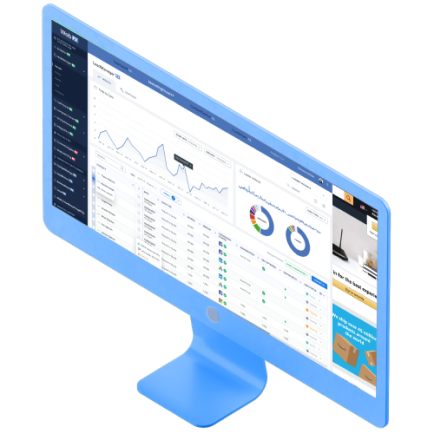-
 Published: Jun 9, 2023
Published: Jun 9, 2023
-
 7 min. read
7 min. read
-
 Matthew Gibbons
Matthew Gibbons Senior Data & Tech Writer
Senior Data & Tech Writer
- Matthew is a marketing expert focusing on the SEO & martech spaces. He has written over 500 marketing guides and video scripts for the WebFX YouTube channel. When he’s not striving to put out some fresh blog posts and articles, he’s usually fueling his Tolkien obsession or working on miscellaneous creative projects.
What is data unification? Data unification is the process of bringing data from several different sources together in one centralized location.
In 1871, a collection of small, loosely connected European states came together to form the nation we now know as Germany. That process was known as the Unification of Germany. But it wasn’t easy to unify so many states with slightly different cultures and backgrounds.
In fact, unification is rarely easy, even within the far simpler context of running a business. For example, successful businesses revolve around data. But that data comes from different sources, and it’s a good idea to bring it all together in one location.
That’s the idea behind data unification. But what is data unification, and what makes it so significant? Read on to get an answer to both of those questions.
Then, to learn more about digital marketing, subscribe to Revenue Weekly, our email newsletter!
Join 200K smart marketers for the hottest marketing news and insights in your inbox. “*” indicates required fieldsDon’t miss our Marketing Manager Insider emails!
Inline Subscription Form


What is data unification?
Data unification is the process of gathering data from different sources and bringing it all together in a single location.
Why does unifying data matter?
When your data is spread out across different platforms, formatted differently on each one, it can be very difficult to gain insights from it. You constantly have to jump from one platform to another. Plus, if you want to create a report using multiple types of data from different platforms, you’re out of luck.
Data unification is the answer to that problem. With it, you can pull data from all your different sources and feed it into a single tool. That way, you can easily access it all from one place. Plus, if you want to compare different types of data, you can easily do so within that centralized platform.
Unified data make things far easier and more convenient and it enables you to gain new insights and find new patterns in your data that you’d never have discovered otherwise.
What makes unifying data challenging?
Data unification isn’t always simple — you’re pulling data from all kinds of different platforms, and all those platforms operate in different ways. Because of that, there are several notable challenges that will inevitably crop up when you attempt to unify data. You need to be aware of those challenges before you begin.
Here are three of the biggest challenges you’ll face when you start unifying data.
1. Different data formats
Firstly, different platforms will format data in different ways. To name one simple example, you might see inconsistencies in the way dates are formatted. One platform might use the format m/d/yy, while another might use yyyy/mm/dd.
Similarly, if you’re tracking info on specific clients, those clients’ names might be formatted differently. One platform might refer to a client simply as “Sirion Boating,” but another might use the full name “Sirion Boating and Fishing, LLC.”
These differences might seem small, but they can make a huge difference when you merge those different datasets into one platform. For example, if different sources format dates differently, then after unification, all your dates will be listed out of order!
2. Duplicate data
Another challenge of unifying data is that platforms will often include duplicates. For example, your marketing and sales teams probably both track data on prospective customers. So, by pulling data from both teams, you could end up getting lots of duplicate info on your leads and prospects.
Worse yet, those duplicate datasets won’t always be consistent. Sometimes your marketing team might have one set of info about a client, but your sales team records something slightly different. Then you have to do the work of figuring out which of the two is correct.
Overall, duplicate data points can lead to clutter and inconsistency within your unified data platform, which is something to avoid.
3. Time commitment
Finally, unifying data can be challenging because of the time and effort required to make it happen. Odds are, you have quite a lot of data, and migrating that data to one centralized platform can be a slow and tedious process.
Plus, data unification isn’t a one-time event. It’s a continuous process, because you’re always generating new data. For many businesses, that means dedicating a segment of their team to data unification, eating up time they could otherwise use on other aspects of their business.
How can you unify data more effectively?
Now that we’ve seen the challenges of data unification, you might be wondering if it’s worth the effort. First of all, let me assure you — it definitely is. Data unification can take your marketing and sales to a whole new level, driving up your revenue significantly.
Secondly, it doesn’t have to be as challenging as the previous section makes it seem. There are tools and techniques you can use to streamline the data unification process. Here are three top-notch tips to help you unify data.
1. Clean your data
In the previous section, we looked at how different datasets can come with a variety of inaccuracies and inconsistencies. Thankfully, there’s a way to fix that issue before you start mixing all your data together. Namely, you can clean your data.
Data cleaning is simply the process of going through a dataset and removing any inaccuracies, inconsistencies, or redundancies. That way, each dataset is ready to go by the time it gets combined with the rest of your data.
You can also use this step as an opportunity to apply a consistent format for things like dates and names.
2. Automate data migration
Another challenge we explored above was time commitment. And it’s true — you’ll have to contribute a certain amount of time and effort to data unification. But it doesn’t have to be as time-consuming as you think. That’s because you can simply use automation to help you.
There are a variety of tools out there that will help you automate the process of migrating and validating data. That means the tools can migrate the data over for you, freeing up your team to spend time on other things. Plus, automation removes the possibility of human error while transferring your data.
3. Harness the right data tools
Finally, it’s crucial to use the right tools for your data unification. Most importantly, you need to figure out which platform will serve as the centralized home for your data. Depending on the type of data you’re dealing with, you could use any of the following types of tools:
- Data management platform (DMP)
- Enterprise resource platform (ERP)
- Customer data platform (CDP)
- Customer relationship management (CRM) platform
Each of those tools is optimized for a slightly different type of data. For instance, a CRM is perfect for storing, organizing, and analyzing data about your leads and customers. Plus, the great thing about a CRM is that it includes lots of automation features, so you don’t have to get a separate automation tool.
One platform tracking countless metrics and driving stellar results.Meet RevenueCloudFX:


RevenueCloudFX and Nutshell can vastly improve your unified data
As we’ve established, data unification can be hard work. It can also be time-consuming to analyze and gain insights from that data once you’ve unified it. At the same time, it’s definitely something you want to do. So, if you don’t have the time, what do you do?
Simple — you partner with a marketing agency like WebFX. With our marketing analytics services, we can help you pull crucial insights from your marketing data. You can also use our proprietary marketing tool, RevenueCloudFX, to help you gather and unify that data from the start.
Plus, when you use RevenueCloudFX, you get several free seats in Nutshell, which is one of the best CRMs on the market. That gives you somewhere to store and organize all your customer data — plus, Nutshell can automate a good bit of the process.
Interested in partnering with us? Just call 888-601-5359 or contact us online today!
-
 Matthew is a marketing expert focusing on the SEO & martech spaces. He has written over 500 marketing guides and video scripts for the WebFX YouTube channel. When he’s not striving to put out some fresh blog posts and articles, he’s usually fueling his Tolkien obsession or working on miscellaneous creative projects.
Matthew is a marketing expert focusing on the SEO & martech spaces. He has written over 500 marketing guides and video scripts for the WebFX YouTube channel. When he’s not striving to put out some fresh blog posts and articles, he’s usually fueling his Tolkien obsession or working on miscellaneous creative projects. -

WebFX is a full-service marketing agency with 1,100+ client reviews and a 4.9-star rating on Clutch! Find out how our expert team and revenue-accelerating tech can drive results for you! Learn more
Try our free Marketing Calculator
Craft a tailored online marketing strategy! Utilize our free Internet marketing calculator for a custom plan based on your location, reach, timeframe, and budget.
Plan Your Marketing Budget

Proven Marketing Strategies

Proven Marketing Strategies
Try our free Marketing Calculator
Craft a tailored online marketing strategy! Utilize our free Internet marketing calculator for a custom plan based on your location, reach, timeframe, and budget.
Plan Your Marketing Budget
What to read next





